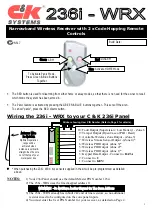
2/14/2007
Page - 14
Final Tests
Your new rig is now just about ready to use. All we need to do now is peak the receiver trimmer and check for
transmitter power output.
For peaking the receiver trimmer, on 30 or 40 you can probably just connect an antenna up and peak the trimmer
for best band noise or signal if someone is transmitting near the crystal frequency. On 20 and 15, you will probably
need to generate a signal using your big rig, transmitting into a dummy load. In this case, you just need to use a
piece of wire or clip lead for an antenna on the DC rig and place it near the dummy load.
Don't plug in a paddle yet,
so you don't
accidentally transmit!
For testing the transmitter, you should have a dummy load and Watt meter which is reasonably accurate at the 1
Watt level. Alternately, you could use a 'scope if it has enough band width or use a simple diode detector and volt
meter.
Connect up an antenna jack if not already done, plug in headphones, paddle and power leads. Turn on power to
the rig. Put the keyer into “Tune Mode”, using the function switch. This will allow you to toggle the transmitter on
and off. Toggle the transmitter on and see if how much power out you get. The amount of power will depend a lot
on supply voltage. With 13.8 Volts, up to 1 Watt and sometimes more is possible. At 12 volts, 700 mW is more
likely. Below 12 Volts, power output starts to drop quickly. The way the turns are spaced on L2 and L3 can also
make a significant difference in the amount of power output, as minor changes in the inductance can affect the
matching and power transfer. If your cores are wound with the turns more or less evenly spaced to start with, try
moving the turns closer together while watching the power output. Go back and forth between L2 and L3 until you
get the most power output you can.
Содержание DC20A
Страница 18: ...2 14 2007 Page 18...




































